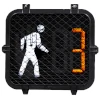 This week's correspondence contained a request to explain what pedestrian signals mean. The gentleman who sent me the e-mail expressed the opinion that many people either did not know what pedestrian signals mean or choose to deliberately disobey them. Would I please explain so that they would know what to do.
This week's correspondence contained a request to explain what pedestrian signals mean. The gentleman who sent me the e-mail expressed the opinion that many people either did not know what pedestrian signals mean or choose to deliberately disobey them. Would I please explain so that they would know what to do.
Traffic Signals in General
Perhaps we should start with traffic signals themselves. They are designed to move vehicular traffic efficiently. In some cases, when they are close together and not synchronized, they don't even do this well.
Pedestrians are a second thought.
Pedestrian Signals
He goes on to say that there are many intersections where the vehicle traffic green light is not linked to the pedestrian crossing indicator which defaults to a solid red hand. You must push the "beg button" to receive a walk signal.
Design standards for walk signals call for three intervals of operation.
Three Intervals
Steady Walk: Pedestrians may start to walk across traffic lanes in a crosswalk. The "WALK" indicator should be displayed for a minimum amount of time, allowing pedestrians time to notice and react to the signal.
A walk interval of 7 seconds should be used. However, if the sum of this interval and the pedestrian clearance time exceeds the maximum green time of the corresponding vehicle phase, a minimum walk interval of 5 seconds may be used.
Flashing Don’t Walk: A flashing red hand symbol indicates it is no longer safe to begin crossing. If the pedestrian has started walking before the signal began to flash, they have enough time to cross the street. Countdown timers (where installed) run for this duration and countdown at the start of flashing hand phase.
Steady Don't Walk: A solid red hand symbol indicates that the pedestrian should not be in the crosswalk at this time. This duration is an interval equivalent to sum of yellow and red time of associated vehicular through phase that allows for any unfinished crossing before a conflicting phase comes on.
I Don't Want to Wait
Once you press the button, he says that it seems ludicrous to stand there for 2-3 minutes while the lights cycle through to permit pedestrians to cross.
Please refer back to the paragraph on traffic signals in general. Nobody likes to wait and that includes drivers, cyclists and pedestrians. Inevitably, someone has to wait and it is usually the pedestrian.
The Countdown Timer
It is his understanding that the pedestrian countdown is a timing mechanism only and does not indicate the legality of initiating or continuing crossing. He's correct.
Times Are Changing, Slowly
Leading pedestrian intervals make drivers wait briefly and represent a change in the way pedestrian signals are timed. When implemented they hold back traffic and allow pedestrians into the crosswalk first. This reduces the chance of a collision with a driver making a turn.
Learn More
- MOTI Signal Design Manual
- Pedestrian Crossing Control Manual for BC
- Intersection Signalization and Timing Plans
Share This Article
I see the writer's statements focus on the provincial standards. That's fine, but cities (and therefore the vast majority of traffic lights) are free to use their own timings and many use the Canadian MUTCD or their own rules.
"Beg buttons" as a term is basically a thought terminating phrase. The buttons only make a pedestrian "beg" as much as the loops in the road make a vehicle "beg" for green. Engineers would love to use more passive modes of detection for pedestrians but most still have reliability issues. In downtown cores where it matters most the lights don't have any detectors and instead cycle through all directions (walk symbols and green lights) one at a time.
Many also wonder why the walk symbol doesn't automatically come up when the green does. The reason is simple. When not needed the long walk and flashing don't walk times needed to ensure pedestrians of all abilities can cross safely end up delaying everyone, including pedestrians, transit riders, and cyclists coming from other directions. In this case the lack of automatic service is a choice made that ensures everyone gets their turn sooner. It's not malicious, just misunderstood based on preconceived notions.
- Log in to post comments
- Log in to post comments

I see the writer's…